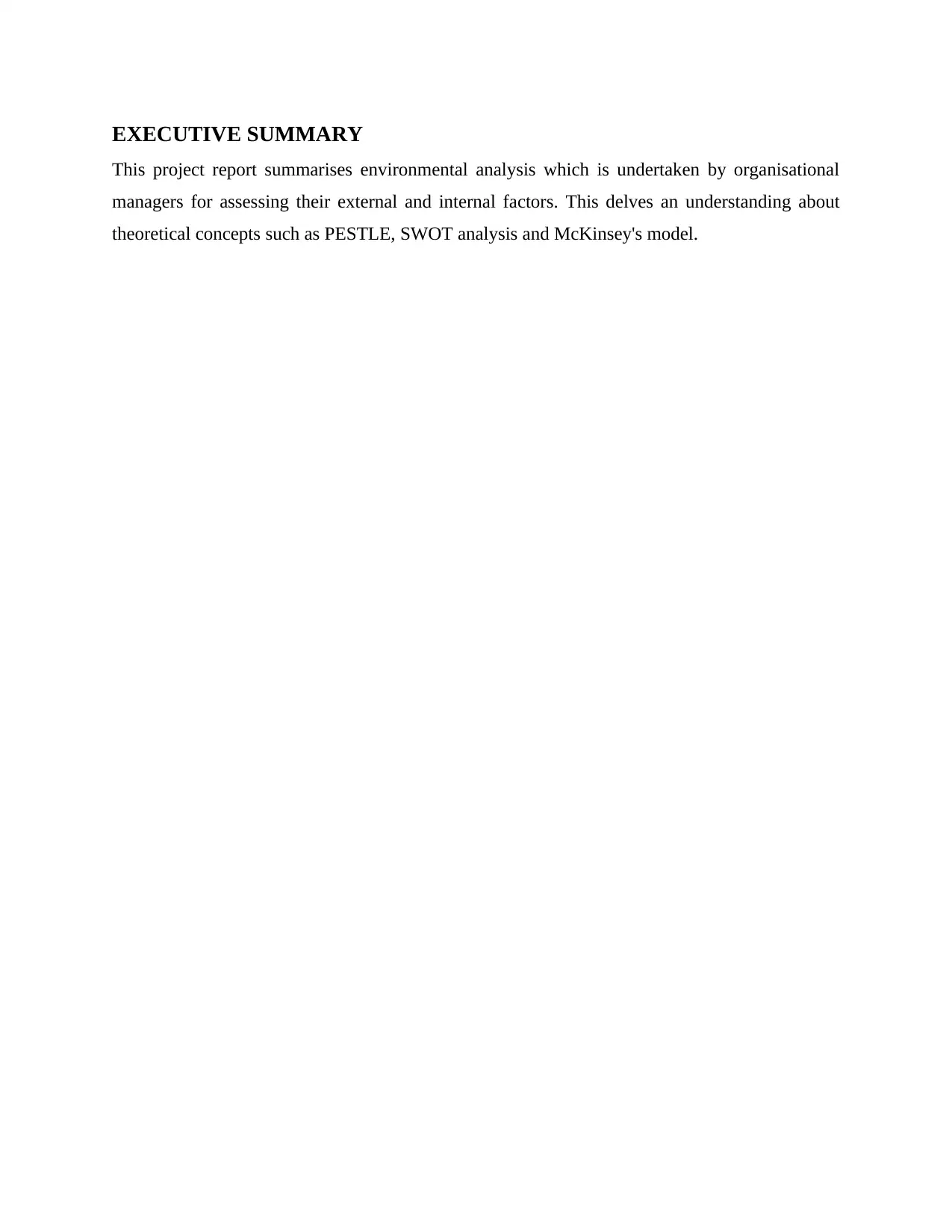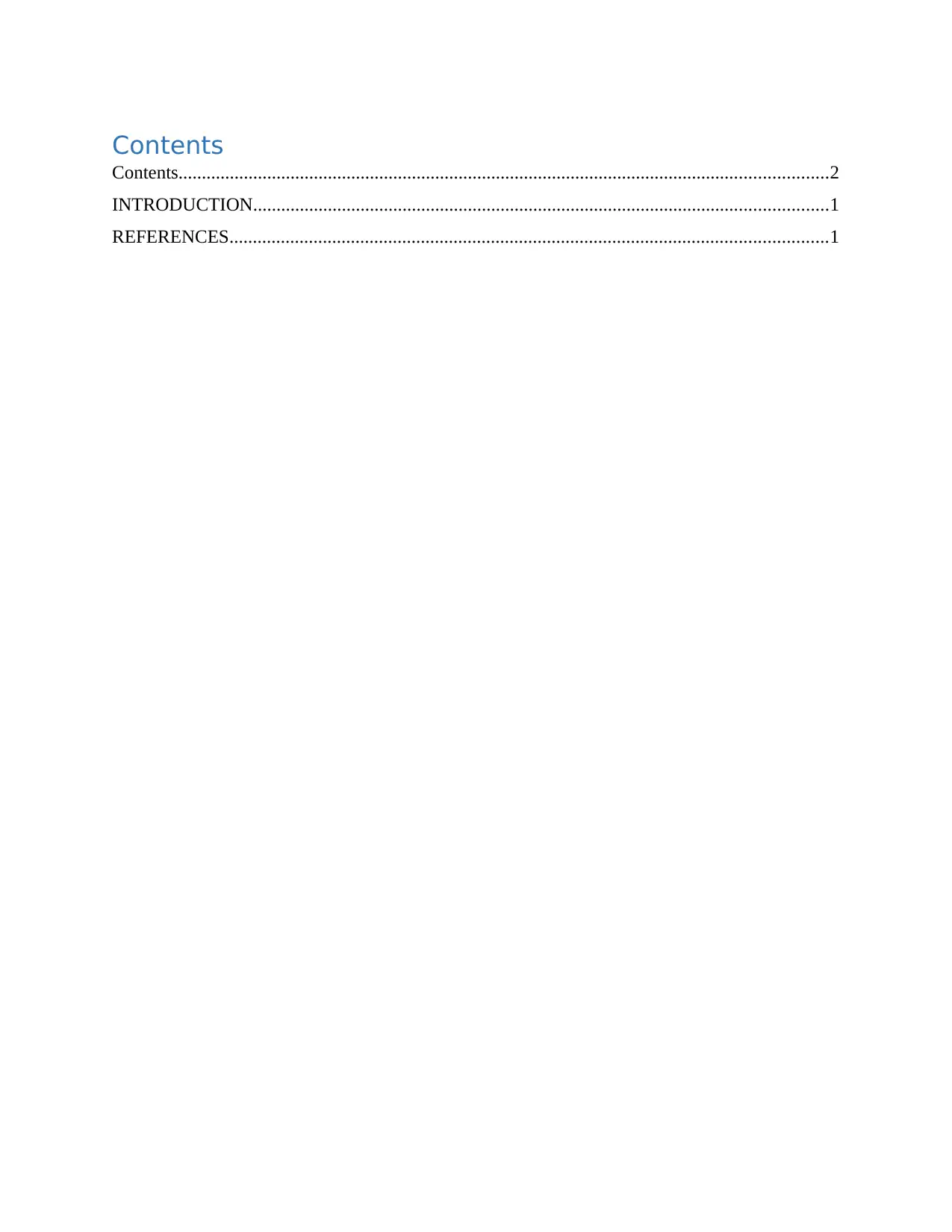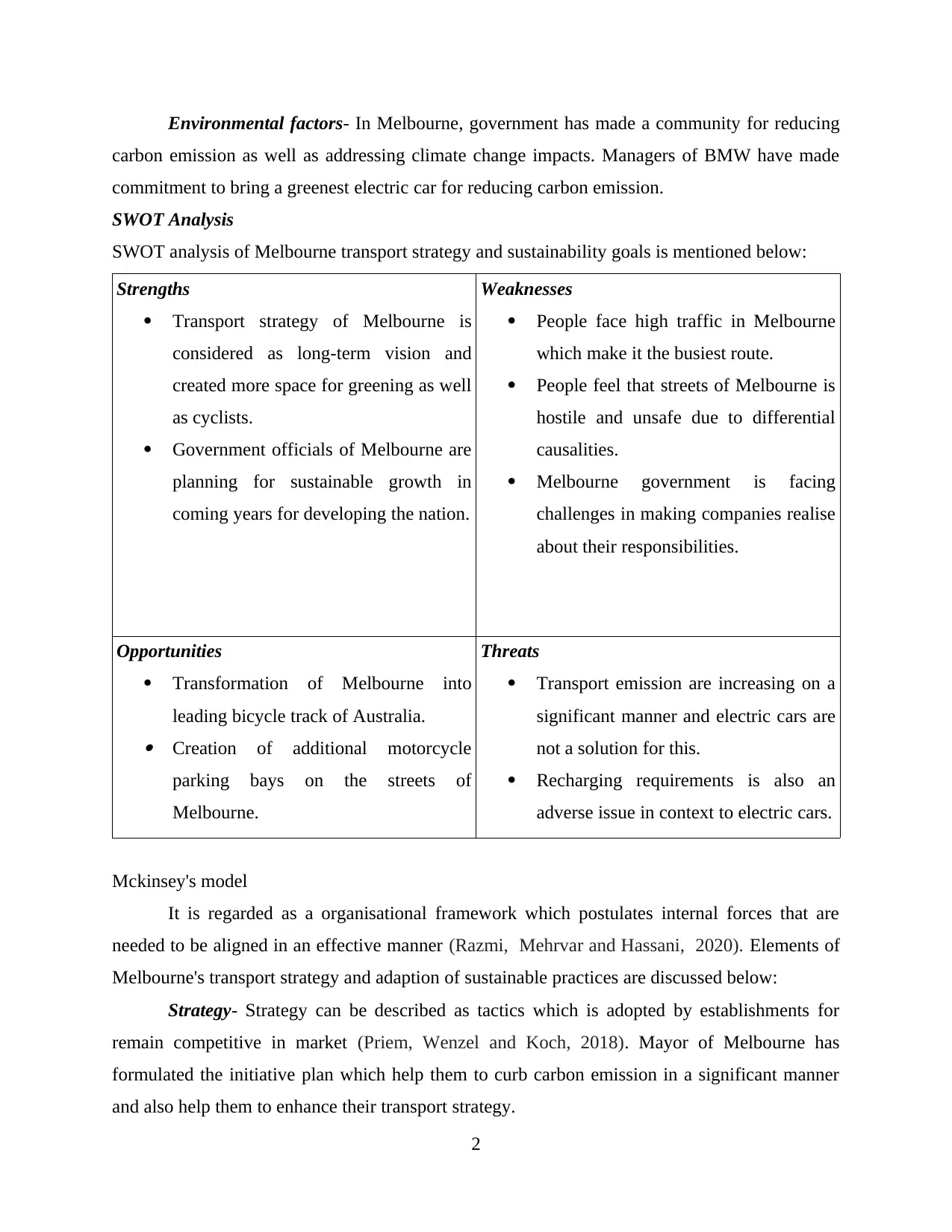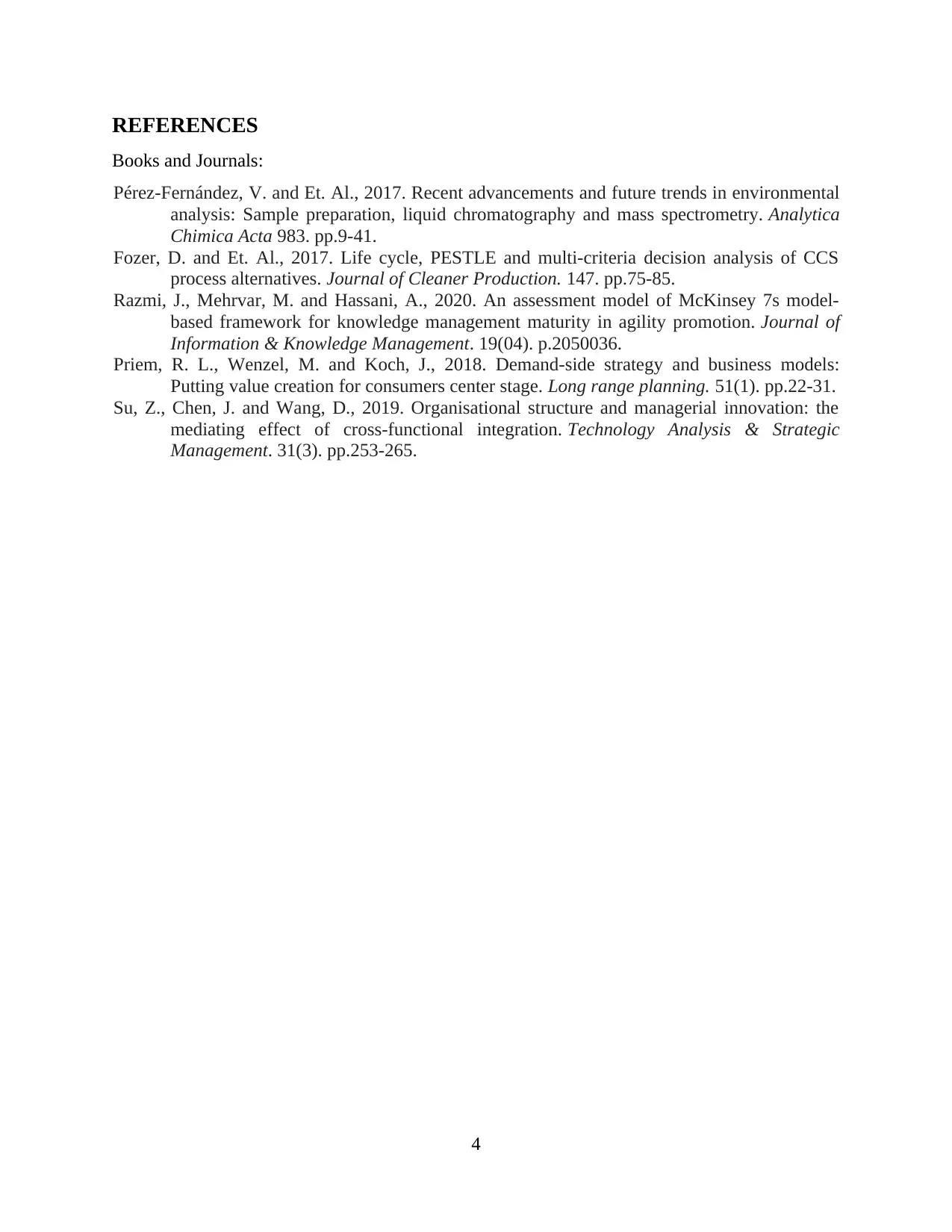BUS101: Environmental Analysis of Melbourne's Business Environment
VerifiedAdded on 2023/06/08
|7
|1253
|193
Report
AI Summary
This report provides an environmental analysis of the business context in Melbourne, focusing on how the BMW challenge might play out within the city's sustainability initiatives. The analysis employs three key theoretical frameworks: PESTLE analysis, SWOT analysis, and McKinsey's 7-S model. The PESTLE analysis examines the political, economic, social, technological, legal, and environmental factors influencing businesses in Melbourne, highlighting opportunities and challenges for BMW. The SWOT analysis evaluates the strengths, weaknesses, opportunities, and threats related to Melbourne's transport strategy and sustainability goals. Finally, McKinsey's 7-S model assesses the internal organizational elements (strategy, structure, systems, shared values, skills, style, and staff) necessary for aligning with Melbourne's sustainability initiatives. The report concludes that organizations must analyze both internal and external environments to make informed decisions regarding future corporate strategy and adapt to changing business landscapes, particularly in the context of sustainability.

Environmental analysis
Paraphrase This Document
Need a fresh take? Get an instant paraphrase of this document with our AI Paraphraser

EXECUTIVE SUMMARY
This project report summarises environmental analysis which is undertaken by organisational
managers for assessing their external and internal factors. This delves an understanding about
theoretical concepts such as PESTLE, SWOT analysis and McKinsey's model.
This project report summarises environmental analysis which is undertaken by organisational
managers for assessing their external and internal factors. This delves an understanding about
theoretical concepts such as PESTLE, SWOT analysis and McKinsey's model.

Contents
Contents...........................................................................................................................................2
INTRODUCTION...........................................................................................................................1
REFERENCES................................................................................................................................1
Contents...........................................................................................................................................2
INTRODUCTION...........................................................................................................................1
REFERENCES................................................................................................................................1
⊘ This is a preview!⊘
Do you want full access?
Subscribe today to unlock all pages.

Trusted by 1+ million students worldwide

INTRODUCTION
Environmental analysis is used by organisational managers for identifying their intrinsic
as well as extrinsic elements which can affect the business operations in a positive or negative
manner (Pérez-Fernández and Et. Al., 2017). It aid organisational managers in anticipating
probable opportunities as well as threats which can impact business activities in a significant
manner. For analysing the environment analysis, Melbourne and BMW challenges are taken into
consideration. This project report delves an understanding about three differential theoretical
concepts which for evaluating internal as well as external environment.
MAIN BODY
PESTLE analysis can be understood as a strategic technique which is used for scanning
external environment which affects business operations in a tremendous manner (Fozer and Et.
Al., 2017). PESTLE analysis of Melbourne and BMW challenges is as follows:
Political factors- Political landscape is stable in Melbourne which makes it significant for
attracting organisational investments from varied establishments. This can be an opportunity for
BMW to operate their functions in an effective manner.
Economic factors- Melbourne is considered as low-cost location for establishments for
enhancing labour costs in an effective manner. These factors led managers of BMW to operate in
an environment which supports their resources.
Social factors- In Melbourne, people are multicultural and multiracial as well as aware
about their health. BMW adopts practices for supporting sustainable practices. People in
Melbourne willing to purchase from those brands which support sustainability.
Technological factors- Melbourne is considered as a nation which supports technological
innovations in regards with business operations. Managers of BMW have adopted automation
techniques for curbing the carbon emission in a significant manner.
Legal factors- Government of Australia has implemented the fair work legislation act
whereby they provide flexible working arrangements and prevent discrimination against
personnel. BMW managers comply with these laws which help them to avoid expansive
litigation.
1
Environmental analysis is used by organisational managers for identifying their intrinsic
as well as extrinsic elements which can affect the business operations in a positive or negative
manner (Pérez-Fernández and Et. Al., 2017). It aid organisational managers in anticipating
probable opportunities as well as threats which can impact business activities in a significant
manner. For analysing the environment analysis, Melbourne and BMW challenges are taken into
consideration. This project report delves an understanding about three differential theoretical
concepts which for evaluating internal as well as external environment.
MAIN BODY
PESTLE analysis can be understood as a strategic technique which is used for scanning
external environment which affects business operations in a tremendous manner (Fozer and Et.
Al., 2017). PESTLE analysis of Melbourne and BMW challenges is as follows:
Political factors- Political landscape is stable in Melbourne which makes it significant for
attracting organisational investments from varied establishments. This can be an opportunity for
BMW to operate their functions in an effective manner.
Economic factors- Melbourne is considered as low-cost location for establishments for
enhancing labour costs in an effective manner. These factors led managers of BMW to operate in
an environment which supports their resources.
Social factors- In Melbourne, people are multicultural and multiracial as well as aware
about their health. BMW adopts practices for supporting sustainable practices. People in
Melbourne willing to purchase from those brands which support sustainability.
Technological factors- Melbourne is considered as a nation which supports technological
innovations in regards with business operations. Managers of BMW have adopted automation
techniques for curbing the carbon emission in a significant manner.
Legal factors- Government of Australia has implemented the fair work legislation act
whereby they provide flexible working arrangements and prevent discrimination against
personnel. BMW managers comply with these laws which help them to avoid expansive
litigation.
1
Paraphrase This Document
Need a fresh take? Get an instant paraphrase of this document with our AI Paraphraser

Environmental factors- In Melbourne, government has made a community for reducing
carbon emission as well as addressing climate change impacts. Managers of BMW have made
commitment to bring a greenest electric car for reducing carbon emission.
SWOT Analysis
SWOT analysis of Melbourne transport strategy and sustainability goals is mentioned below:
Strengths
Transport strategy of Melbourne is
considered as long-term vision and
created more space for greening as well
as cyclists.
Government officials of Melbourne are
planning for sustainable growth in
coming years for developing the nation.
Weaknesses
People face high traffic in Melbourne
which make it the busiest route.
People feel that streets of Melbourne is
hostile and unsafe due to differential
causalities.
Melbourne government is facing
challenges in making companies realise
about their responsibilities.
Opportunities
Transformation of Melbourne into
leading bicycle track of Australia. Creation of additional motorcycle
parking bays on the streets of
Melbourne.
Threats
Transport emission are increasing on a
significant manner and electric cars are
not a solution for this.
Recharging requirements is also an
adverse issue in context to electric cars.
Mckinsey's model
It is regarded as a organisational framework which postulates internal forces that are
needed to be aligned in an effective manner (Razmi, Mehrvar and Hassani, 2020). Elements of
Melbourne's transport strategy and adaption of sustainable practices are discussed below:
Strategy- Strategy can be described as tactics which is adopted by establishments for
remain competitive in market (Priem, Wenzel and Koch, 2018). Mayor of Melbourne has
formulated the initiative plan which help them to curb carbon emission in a significant manner
and also help them to enhance their transport strategy.
2
carbon emission as well as addressing climate change impacts. Managers of BMW have made
commitment to bring a greenest electric car for reducing carbon emission.
SWOT Analysis
SWOT analysis of Melbourne transport strategy and sustainability goals is mentioned below:
Strengths
Transport strategy of Melbourne is
considered as long-term vision and
created more space for greening as well
as cyclists.
Government officials of Melbourne are
planning for sustainable growth in
coming years for developing the nation.
Weaknesses
People face high traffic in Melbourne
which make it the busiest route.
People feel that streets of Melbourne is
hostile and unsafe due to differential
causalities.
Melbourne government is facing
challenges in making companies realise
about their responsibilities.
Opportunities
Transformation of Melbourne into
leading bicycle track of Australia. Creation of additional motorcycle
parking bays on the streets of
Melbourne.
Threats
Transport emission are increasing on a
significant manner and electric cars are
not a solution for this.
Recharging requirements is also an
adverse issue in context to electric cars.
Mckinsey's model
It is regarded as a organisational framework which postulates internal forces that are
needed to be aligned in an effective manner (Razmi, Mehrvar and Hassani, 2020). Elements of
Melbourne's transport strategy and adaption of sustainable practices are discussed below:
Strategy- Strategy can be described as tactics which is adopted by establishments for
remain competitive in market (Priem, Wenzel and Koch, 2018). Mayor of Melbourne has
formulated the initiative plan which help them to curb carbon emission in a significant manner
and also help them to enhance their transport strategy.
2

Structure- Structure of an establishment is encompasses of corporate hierarchy, chain of
command as well as divisional makeup which helps in outlining the business operations (Su,
Chen and Wang, 2019). Due to massive size if operations at global scale, they follow highly
complex structure in an effective manner.
Systems- It refer to daily routine procedures, workflows as well as decisions which
organise standard operations of an establishment. Managers of BMW are trying to develop
varied innovative practices on a daily procedures in order to bring sustainability.
Shared Values- These can be understood as accepted standards as well as norms within
an establishment which impact behaviour of entire staff. Managers of BMW have shared values
regarding adoption of sustainable practices in their operations. They also encourage their staff for
working through the shared values of adopting sustainable practices.
Skills- These comprises of talents as well as capabilities which is used for determining
achievements and formulating strategy in an effective manner. Managers of BMW develop skills
and capabilities of their employees so that they can work for enhancing sustainable practices in
their operating country.
Style- This can be described as examples as well as approaches which is undertaken by
management for leading the company. This consists of productivity, corporate culture, employee
performance and many more. Employee performance of BMW company is assessed through
degree of implementation of sustainable practices.
Staff- It is essentially related to the employees of organisation, their motivating force and
training needs and many more. Managers of BMW motivate their staff to work in a cordial and
flexible environment in an effective manner.
CONCLUSION
From the above presented information, it has been concluded that it is imperative for
organisations to analyse the internal as well as external environment in which they are operating.
McKinsey's model is used by organisational managers for making decisions regarding future
corporate strategy in an effective manner. SWOT analysis is used by establishments for assessing
their internal environment in a strategic manner. Organisational managers also use PESTLE
analysis for evaluating the external forces which can impact their practices.
3
command as well as divisional makeup which helps in outlining the business operations (Su,
Chen and Wang, 2019). Due to massive size if operations at global scale, they follow highly
complex structure in an effective manner.
Systems- It refer to daily routine procedures, workflows as well as decisions which
organise standard operations of an establishment. Managers of BMW are trying to develop
varied innovative practices on a daily procedures in order to bring sustainability.
Shared Values- These can be understood as accepted standards as well as norms within
an establishment which impact behaviour of entire staff. Managers of BMW have shared values
regarding adoption of sustainable practices in their operations. They also encourage their staff for
working through the shared values of adopting sustainable practices.
Skills- These comprises of talents as well as capabilities which is used for determining
achievements and formulating strategy in an effective manner. Managers of BMW develop skills
and capabilities of their employees so that they can work for enhancing sustainable practices in
their operating country.
Style- This can be described as examples as well as approaches which is undertaken by
management for leading the company. This consists of productivity, corporate culture, employee
performance and many more. Employee performance of BMW company is assessed through
degree of implementation of sustainable practices.
Staff- It is essentially related to the employees of organisation, their motivating force and
training needs and many more. Managers of BMW motivate their staff to work in a cordial and
flexible environment in an effective manner.
CONCLUSION
From the above presented information, it has been concluded that it is imperative for
organisations to analyse the internal as well as external environment in which they are operating.
McKinsey's model is used by organisational managers for making decisions regarding future
corporate strategy in an effective manner. SWOT analysis is used by establishments for assessing
their internal environment in a strategic manner. Organisational managers also use PESTLE
analysis for evaluating the external forces which can impact their practices.
3
⊘ This is a preview!⊘
Do you want full access?
Subscribe today to unlock all pages.

Trusted by 1+ million students worldwide

REFERENCES
Books and Journals:
Pérez-Fernández, V. and Et. Al., 2017. Recent advancements and future trends in environmental
analysis: Sample preparation, liquid chromatography and mass spectrometry. Analytica
Chimica Acta 983. pp.9-41.
Fozer, D. and Et. Al., 2017. Life cycle, PESTLE and multi-criteria decision analysis of CCS
process alternatives. Journal of Cleaner Production. 147. pp.75-85.
Razmi, J., Mehrvar, M. and Hassani, A., 2020. An assessment model of McKinsey 7s model-
based framework for knowledge management maturity in agility promotion. Journal of
Information & Knowledge Management. 19(04). p.2050036.
Priem, R. L., Wenzel, M. and Koch, J., 2018. Demand-side strategy and business models:
Putting value creation for consumers center stage. Long range planning. 51(1). pp.22-31.
Su, Z., Chen, J. and Wang, D., 2019. Organisational structure and managerial innovation: the
mediating effect of cross-functional integration. Technology Analysis & Strategic
Management. 31(3). pp.253-265.
4
Books and Journals:
Pérez-Fernández, V. and Et. Al., 2017. Recent advancements and future trends in environmental
analysis: Sample preparation, liquid chromatography and mass spectrometry. Analytica
Chimica Acta 983. pp.9-41.
Fozer, D. and Et. Al., 2017. Life cycle, PESTLE and multi-criteria decision analysis of CCS
process alternatives. Journal of Cleaner Production. 147. pp.75-85.
Razmi, J., Mehrvar, M. and Hassani, A., 2020. An assessment model of McKinsey 7s model-
based framework for knowledge management maturity in agility promotion. Journal of
Information & Knowledge Management. 19(04). p.2050036.
Priem, R. L., Wenzel, M. and Koch, J., 2018. Demand-side strategy and business models:
Putting value creation for consumers center stage. Long range planning. 51(1). pp.22-31.
Su, Z., Chen, J. and Wang, D., 2019. Organisational structure and managerial innovation: the
mediating effect of cross-functional integration. Technology Analysis & Strategic
Management. 31(3). pp.253-265.
4
1 out of 7
Related Documents
Your All-in-One AI-Powered Toolkit for Academic Success.
+13062052269
info@desklib.com
Available 24*7 on WhatsApp / Email
![[object Object]](/_next/static/media/star-bottom.7253800d.svg)
Unlock your academic potential
Copyright © 2020–2025 A2Z Services. All Rights Reserved. Developed and managed by ZUCOL.





